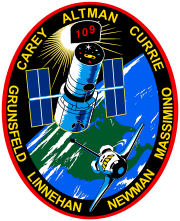
Back STS-109 Arabic STS-109 Bulgarian STS-109 Catalan STS-109 Czech STS-109 Danish STS-109 German STS-109 Spanish STS-109 Estonian استیاس-۱۰۹ Persian STS-109 French
 The Hubble Space Telescope in Columbia's payload bay towards the end of the mission | |
| Names | Space Transportation System-109 |
|---|---|
| Mission type | Hubble servicing |
| Operator | NASA |
| COSPAR ID | 2002-010A |
| SATCAT no. | 27388 |
| Mission duration | 10 days, 22 hours, 11 minutes, 09 seconds |
| Distance travelled | 6,300,000 kilometres (3,900,000 mi) |
| Orbits completed | 165 |
| Spacecraft properties | |
| Spacecraft | Space Shuttle Columbia |
| Launch mass | 116,989 kg (257,917 lb) |
| Landing mass | 100,564 kg (221,706 lb) |
| Crew | |
| Crew size | 7 |
| Members | |
| Start of mission | |
| Launch date | 1 March 2002 11:22:02 UTC |
| Launch site | Kennedy LC-39A |
| End of mission | |
| Landing date | 12 March 2002 09:33:10 UTC |
| Landing site | Kennedy SLF Runway 33 |
| Orbital parameters | |
| Reference system | Geocentric |
| Regime | Low Earth |
| Perigee altitude | 486 km (302 mi) |
| Apogee altitude | 578 km (359 mi) |
| Inclination | 28.5 degrees |
| Period | 95.3 minutes |

 (L-R): Michael J. Massimino, Richard M. Linnehan, Duane G. Carey, Scott D. Altman, Nancy J. Currie, John M. Grunsfeld and James H. Newman. | |
STS-109 (SM3B) was a Space Shuttle mission that launched from the Kennedy Space Center on 1 March 2002. It was the 108th mission of the Space Shuttle program,[1] the 27th flight of the orbiter Columbia[1] and the fourth servicing of the Hubble Space Telescope.[2] It was also the last successful mission of the orbiter Columbia before the ill-fated STS-107 mission, which culminated in the Columbia disaster.
The Hubble Space Telescope (HST) was placed in orbit during mission STS-31 on 25 April 1990.[3] Initially designed to operate for 15 years, plans for periodic service and refurbishment were incorporated into its mission from the start.[4] After the successful completion of the second planned service mission (SM2) by the crew of STS-82 in February 1997, three of the telescope's six gyroscopes failed. NASA decided to split the third planned service mission into two parts, SM3A and SM3B.[5] A fifth and final servicing mission, STS-125 (SM4) launched on 11 May 2009.[6] The work performed during SM4 kept HST in operation through 2021.[7]
- ^ a b "Mission STS-109". NASA. Archived from the original on 18 March 2017. Retrieved 1 March 2009.
- ^ "The Hubble Space Telescope: SM3B". NASA. Archived from the original on 22 January 2009. Retrieved 1 March 2009.
- ^ "The Hubble Space Telescope: Deployment". NASA. Archived from the original on 7 March 2009. Retrieved 1 March 2009.
- ^ "Servicing History and Long-Term Plans" (PDF). NASA. June 1993. Retrieved 1 March 2009.
- ^ "The Hubble Space Telescope: SM3A". NASA. Archived from the original on 20 March 2009. Retrieved 1 March 2009.
- ^ "STS-125: Final Shuttle Mission to Hubble Space Telescope". NASA. Retrieved 1 March 2009.
- ^ "The Hubble Space Telescope: SM4". NASA. Archived from the original on 22 January 2009. Retrieved 1 March 2009.
© MMXXIII Rich X Search. We shall prevail. All rights reserved. Rich X Search